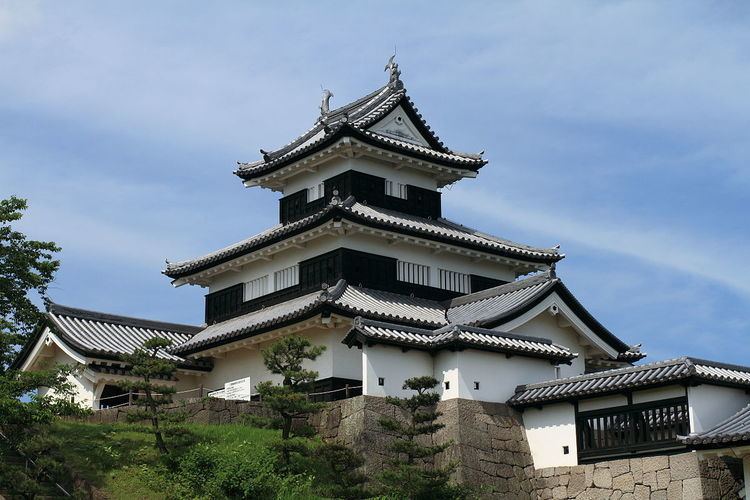 | ||
Shirakawa Domain (白河藩, Shirakawa-han) was a feudal domain under the Tokugawa shogunate of Edo period Japan, located in southern Mutsu Province. It was centered on Komine Castle in what is now the city of Shirakawa, Fukushima. Its most famous ruler was Matsudaira Sadanobu, the architect of the Kansei Reforms. It was also the scene of one of the battles of the Boshin War of the Meiji restoration.
Contents
History
The Shirakawa Barrier was noted from the Nara period as the border between the “settled” regions of Japan proper, and the “frontier” regions of northern Japan, and was of great strategic importance. During the Sengoku period, the area around Shirakawa was controlled by the rulers of Aizu.
In 1627, Niwa Nagashige, one of Tokugawa Ieyasu’s generals, was transferred from Tanakura Domain to the newly established Shirakawa Domain, with revenues of 100,700 koku. He built Komine Castle, and established the surrounding castle town. He was followed by his son, Niwa Mitsushige in 1637, but the clan was transferred to Nihonmatsu Domain in 1647. The Niwa were replaced by Sasakibara Tadatsugu from Tatebayashi Domain, with an increase in revenues to 140,000 koku. Tadatsugu’s mother was one of Ieyasu’s concubines, and for a time he adopted the Matsudaira name. However, his tenure at Shirakawa was short, and he was transferred to Himeji Domain in 1649.
The domain was then assigned to Honda Tadayoshi, formerly of Murakami Domain, and its size was reduced to 120,000 koku. Tadayoshi placed strong efforts into the development of new rice lands, raising his actual revenues by an additional 15,000 koku . In the 1650-1651 period, his actual revenues were 37,000 koku higher than his official rating. However, this disparity and complaints from his subjects on harsh and excessive taxation, led to his son, Honda Tadahira, being transferred to Utsunomiya Domain in 1681.
Shirakawa was then assigned to Matsudaira (Okudaira) Tadahiro, but he was in poor health and assigned running the domain to his karō. Furthermore, the early death of his sons led to an O-oesodo which divided his retainers between a faction favoring a son-in-law and a faction favoring a grandson. His inability to resolve this crisis resulted in his demotion and replacement by another branch of the Matsudaira clan.
Matsudaira (Echizen) Naonori became daimyō of Shirakawa in 1692 and initially implemented plans to repair the domain’s finances through fiscal restraint and reduction of the income of his retainers. These policies were reversed in 1720 by the powerful Toki-faction within the clan, whose solution to the domain’s finances was a drastic increase in taxation. This resulted in a major peasant uprising. Naonori’s successor, Motochika, initiated a suggestion box, and his successor Yoshichika was transferred to Himeji Domain in 1741.
Shirakawa then came under yet another branch of the Matsudaira clan, with the appointment of Matsudaira (Hisamatsu) Tadayoshi. His adopted grandson, Matsudaira Sadanobu was immediately faced with his domain's economically disastrous position: of 110,000 koku that it was supposed to be able to produce, 108,600 had been reported "lost". Sadanobu worked ceaselessly to fix the economic situation in Shirakawa, finally saving it and bringing its finances and agriculture back to stability. These reforms, coupled with Sadanobu's continued political maneuvering, brought him fame, and he was named chief councilor of the Shogunate in the summer of 1787, and regent to the 11th shogun Tokugawa Ienari early the following year. This period of Sadanobu's strengthening of the already faltering Tokugawa regime is known as the Kansei Reforms. His son, Matsudaira Sadanaga, was transferred to Kuwana Domain. Shirakawa was then assigned to the Abe clan of Oishi Domain, who ruled over eight generations to the Meiji restoration. The 7th daimyo, Abe Masato, rose to the post of rōju, and played an important role in the opening of Japan. He overcame the objections of the sonno joi party, and negotiated the opening of Hyōgo Port of the foreigners, but this act precipitated his forced retirement and loss of 40,000 koku in revenue. During the Bakumatsu period, the 8th and final daimyō, Abe Masakiyo, was transferred to Tanakura Domain in 1866. Shirakawa then became tenryō territory administered directly by the Tokugawa shogunate, but the Boshin War began before a new daimyo could be appointed. Shirakawa joined the Ōuetsu Reppan Dōmei and Abe Masakiyo returned briefly in 1868, but the castle was destroyed by Satchō Alliance forces during the Battle of Aizu in the Boshin War.
After the end of the conflict, Shirakawa Domain was dissolved in December 1868, and became Shirakawa Prefecture in August 1869. After the abolition of the han system in July 1871, it became part of “Nihonmatsu Prefecture”, which later became part of Fukushima Prefecture.
Holdings at the end of the Edo period
As with most domains in the han system, Shirakawa Domain consisted of several discontinuous territories calculated to provide the assigned kokudaka, based on periodic cadastral surveys and projected agricultural yields.
